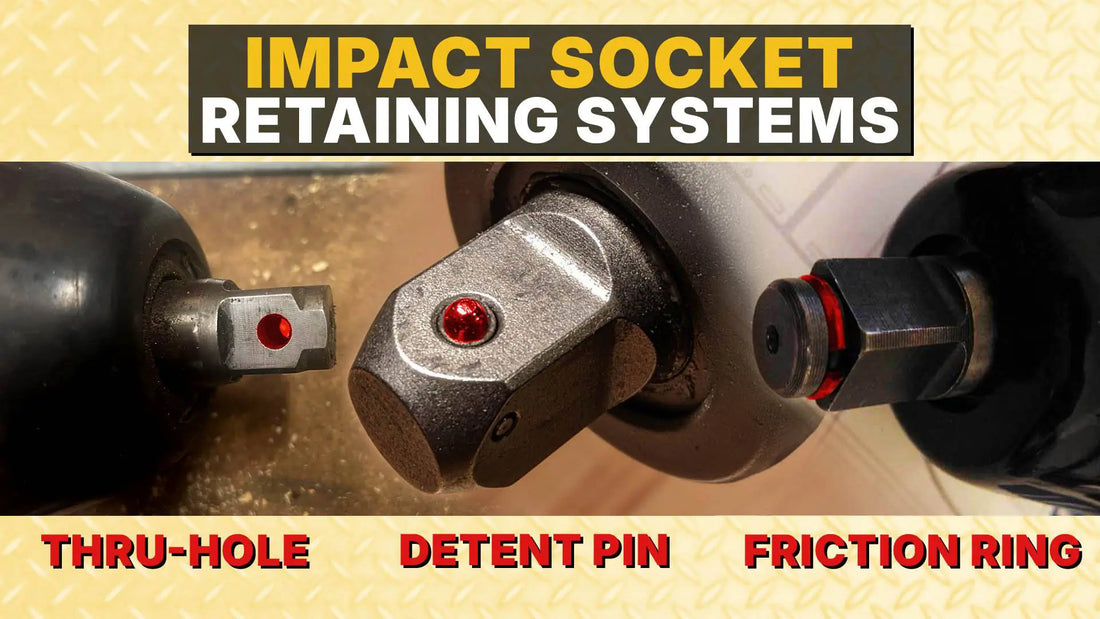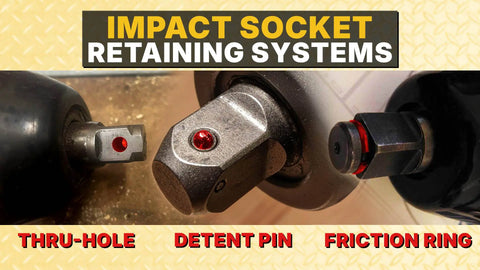
Friction Ring, Detent Pin, Pin and O-ring? Impact Socket Retaining Systems
Written by Luis Montes
Updated On November 13, 2024

Featured Tools
+

Written by Luis Montes
Updated On November 13, 2024

+
Photo sources: www.garagejournal.com / www.reddit.com
Let’s break down the most common impact socket retaining systems, which prevent the sockets from coming off the anvil of impact wrenches during operation.
We’ll compare the mechanisms of friction rings (hog rings), detent pins, and the pin & O-ring system and discuss some interesting misconceptions.

Photo source: www.youtube.com/@FIXTechGuides
The friction ring, also known as the hog ring, is in a groove at the end of an impact wrench anvil. It consists of a steel ring over a neoprene O-ring. The rubber ring expands the diameter of the steel ring, exerting enough force on the inner walls of the socket to keep it in place.

Photo source: www.youtube.com/@singlecams
A detent pin is a three-item mechanism: a mushroom-like pin, a spring, and a roll pin that keeps the detent pin in place.

The detent pin engages a hole in the internal section of the impact socket, keeping it tightly secured on the wrench anvil.

Photo source: www.youtube.com/@mlacher100
Some impact sockets feature two opposite holes inside a groove near their socket drives. You can secure these sockets with a pin that runs through it and a rubber O-ring that prevents the pin from getting off.

All the Ko-ken impact sockets are compatible with the locking pin and O-ring system to ensure maximum safety at the work site.
If you want to be ahead of the curve, you need the Ko-ken impact sockets. Visit the Fortis HD website to order yours.

Source: www.youtube.com/@KokenUSA
The system can work along friction rings, as seen in the image below.

Photo source: www.youtube.com/@KokenUSA
A pin + O-ring system variation fuses both into a single item. At least two products of this kind exist.
The ret ring (image below) is a plastic version. It features a crush gauge on the resin pin, which indicates when a socket is excessively worn and must be replaced.
Although it may sound cool, you can tell when a socket is worn because it has excessive play or got mushroomed, as we mention in our article about Ko-ken thin wall impact sockets.

In addition, a plastic security retaining ring is not what you would expect for heavy-duty tools. They are fragile and might break while being installed, which is exactly what happened to this mechanic, not once but twice in a row.

Source: www.youtube.com/@KokenUSA
Metal rings, such as Ko-ken C-rings, are what you would expect for heavy-duty tools. Their design ensures socket retention and makes installation and removal quick.

The hog ring is for decent socket retention with ease of swapping.
Detent pins have better retention but aren’t as user-friendly for frequent changes.
The purpose of the detent pin is to ensure the socket stays on. If you line it up with the indent in the socket, it will lock on, making it safe for commercial and industrial sites where you might need to comply with safety regulations, as discussed in our article about the Mueller Kueps wrench extender.
According to mechanics, the downside of the detent pin is that it isn’t as user-friendly for frequent changes. To remove the socket, you’ll need a screwdriver or punch to push the pin into the anvil/drive of the impact wrench.
The locking pin with the O-ring system is the most secure attachment and is easier to work with than spring-loaded pin retainers.
Unlike friction rings and detent pins, a high-quality lock pin and O-ring retainer have the advantage of not getting worn. And if you break one, they come in a package of several units.
Let’s review some claims we have encountered that, if not analyzed objectively, will cost you time and money or lead to an accident.
No. The retention system just keeps the socket in place. The impact wrench anvil drives the socket. Period.
Not necessarily. You can replace detent pins, as well as friction rings. In the links below, we share tutorials on how to do both repair tasks:
Absolutely no. We found a crazy accident in which a guy took an impact wrench by the socket without knowing a welding wire was holding it to the anvil. He accidentally activated the tool with his other hand, and the welding wire went through his hand.Check it out.
Using an impact wrench with a detent pin on a non-drilled socket or not lining up the pin with the socket’s hole to hook it is like trying to eat soup with a fork.
The detent pin will apply pressure just on one point, whereas a hog ring applies it on four.
Using the detent pin this way gives the sense of holding the socket, but the fact that it can come off so easily shows its inefficiency and nonsense.
Pretty much, though, it isn’t written on stone.
As you can see in the table below, some brands include the thru-hole anvil even on their 1/2″ models. But, yeah, overall, the anvil w/thru hole features on 3/4″ or greater impact wrenches.
| 1/4" DRIVE CORDLESS IMPACT WRENCH | |||
|---|---|---|---|
| Brand | Model | Max Torque | Anvil Type |
 |
2552-20 | 100 ft-lb | Friction ring |
 |
CT825DB | 100 ft-lb | Friction ring |
 |
MCF901 | 71 ft-lb | Friction ring |
| 3/8" DRIVE CORDLESS IMPACT WRENCH | |||
| Brand | Model | Max Torque | Anvil Type |
 |
2854-20 | 250 ft-lb | Friction ring |
 |
CT9010W1 | 325 ft-lb | Friction ring |
 |
DCF913P2 | 400 ft-lb | Friction ring |
| 1/2" DRIVE CORDLESS IMPACT WRENCH | |||
| Brand | Model | Max Torque | Anvil Type |
 |
2767-20 | 1,400 ft-lb | Friction ring |
 |
GDS18V-221N | 221 ft-lb | Friction ring w/ Thru-hole |
 |
DCF899B | 1,200 ft-lb | Detent pin |
| 3/4" DRIVE CORDLESS IMPACT WRENCH | |||
| Brand | Model | Max Torque | Anvil Type |
 |
2764-22 | 1,200 ft-lb | Friction ring w/ Thru-hole |
 |
CT9100 | 1,300 ft-lb | Friction ring |
 |
DCF897B | 1,200 ft-lb | Friction ring w/ Thru-hole |
 |
2242016 | 645 ft-lb | Through-hole |
| 1" DRIVE CORDLESS IMPACT WRENCH | |||
| Brand | Model | Max Torque | Anvil Type |
 |
2869-20 | 2,000 ft-lb | Friction ring w/ Thru-hole |
 |
285B-6 | 1,475 ft-lb | Friction ring w/ Thru-hole |
By looking at the testimony of several mechanics, friction rings are the most popular retaining option. They let you swap between impact sockets quickly and offer decent retention.
Although detent pins positively retain sockets to the anvil, people find it time-consuming to punch the pin whenever they need to remove sockets.
The pin and O-ring system is the most secure, but its design matters. Don’t waste your time with plastic ones. Go with metal, preferably using a single-item system like the Ko-ken C-ring.

For professionals who need a powerful tool in compact form, the 1/2″ Ultra Short Impact Wrench with friction ring is a perfect choice.
It is essential for mechanics who demand efficiency and versatility in their work. Check it out in the Fortis HD tool section.